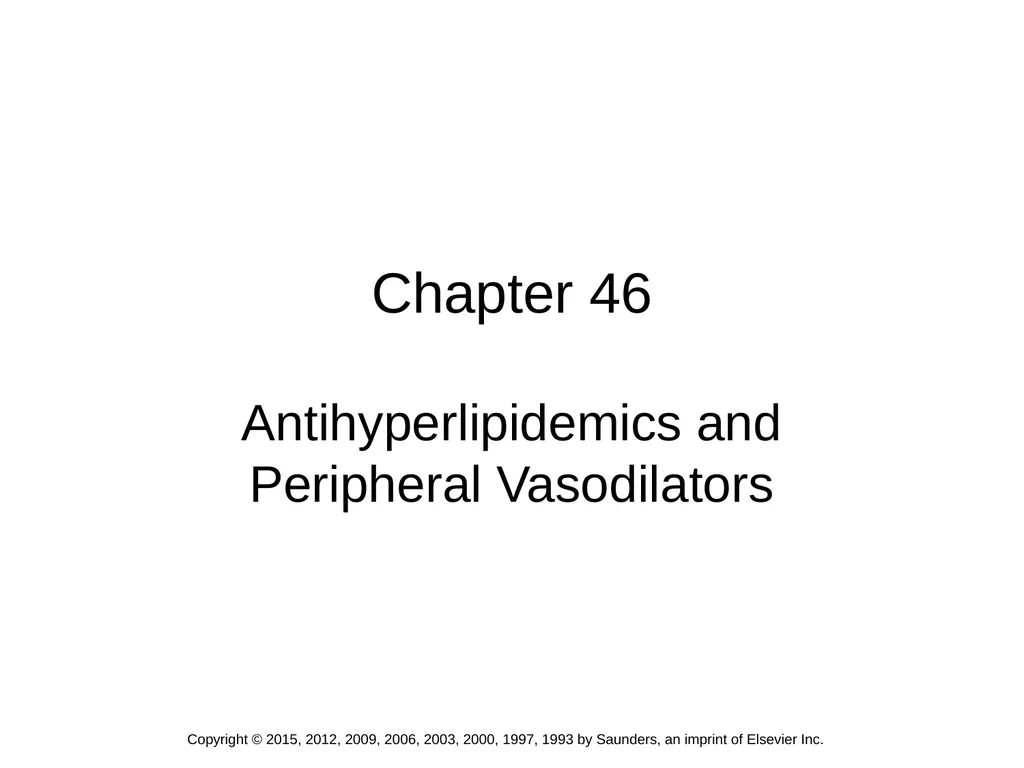Chapter 46 Antihyperlipidemics and Peripheral
Author : lindy-dunigan | Published Date : 2025-05-13
Description: Chapter 46 Antihyperlipidemics and Peripheral Vasodilators Copyright 2015 2012 2009 2006 2003 2000 1997 1993 by Saunders an imprint of Elsevier Inc Lipoproteins Major categories Highdensity lipoprotein HDL good Removes
Presentation Embed Code
Download Presentation
Download
Presentation The PPT/PDF document
"Chapter 46 Antihyperlipidemics and Peripheral" is the property of its rightful owner.
Permission is granted to download and print the materials on this website for personal, non-commercial use only,
and to display it on your personal computer provided you do not modify the materials and that you retain all
copyright notices contained in the materials. By downloading content from our website, you accept the terms of
this agreement.
Transcript:Chapter 46 Antihyperlipidemics and Peripheral:
Chapter 46 Antihyperlipidemics and Peripheral Vasodilators Copyright © 2015, 2012, 2009, 2006, 2003, 2000, 1997, 1993 by Saunders, an imprint of Elsevier Inc. Lipoproteins Major categories High-density lipoprotein (HDL) (“good”) Removes cholesterol from blood Transports cholesterol to liver for elimination Low-density lipoprotein (LDL) (“bad”) Contains higher percent of cholesterol Very low-density lipoprotein (VLDL) Contains mostly triglycerides, less cholesterol Chylomicrons Contain mostly triglycerides Transport fatty acids and cholesterol to liver Copyright © 2015, 2012, 2009, 2006, 2003, 2000, 1997, 1993 by Saunders, an imprint of Elsevier Inc. Apolipoproteins Apolipoproteins are within the lipoprotein shell and contain apolipoprotein (apo) A-1, apoB, and apoE. Major component of apoA1 is HDL. The major component of apoB is LDL. Two forms: apoB-100 and apoB-48 Contains higher percent of cholesterol ApoB-100 has a VLDL as well as LDL Better indicator of risk for coronary artery disease (CAD) than LDL alone Copyright © 2015, 2012, 2009, 2006, 2003, 2000, 1997, 1993 by Saunders, an imprint of Elsevier Inc. Nonpharmacologic Methods for Cholesterol Reduction Reduce saturated fats in diet. Reduce total fat intake to 30% or less of caloric intake. Reduce cholesterol intake to 300 mg/day or less. Exercise as possible. Stop smoking. Copyright © 2015, 2012, 2009, 2006, 2003, 2000, 1997, 1993 by Saunders, an imprint of Elsevier Inc. Antihyperlipidemics Types of antilipidemics Bile-acid sequestrants Fibrates (fibric acid) Nicotinic acid Cholesterol absorption inhibitor Hepatic 3-hydroxy-3-methylglutaryl-coenzyme A (HMG-CoA) reductase inhibitors (statins) Copyright © 2015, 2012, 2009, 2006, 2003, 2000, 1997, 1993 by Saunders, an imprint of Elsevier Inc. Antihyperlipidemics (Cont.) Bile-acid sequestrants Cholestyramine (Questran), colestipol (Colestid), colesevelam HCl Reduce LDL cholesterol (LDL-C) levels by binding with bile acids in the intestine Side effects–constipation, flatulence, and cramping Copyright © 2015, 2012, 2009, 2006, 2003, 2000, 1997, 1993 by Saunders, an imprint of Elsevier Inc. Antihyperlipidemics (Cont.) Fibrates Gemfibrozil (Lopid) Do not take with anticoagulants. Nicotinic acid (Niacin, vitamin B2) Numerous side effects Large doses are required. As few as 20% of patients can initially tolerate niacin. With proper counseling, careful drug titration, and concomitant use of aspirin, this number can be increased to as high as 60% to 70%. Copyright © 2015, 2012, 2009, 2006, 2003, 2000, 1997, 1993 by Saunders, an imprint of Elsevier Inc. Antihyperlipidemics (Cont.) Cholesterol absorption inhibitor Ezetimibe (Zetia) Acts on the cells in the small intestine to inhibit cholesterol absorption It must be combined with a statin for optimum effect. Copyright © 2015, 2012,














